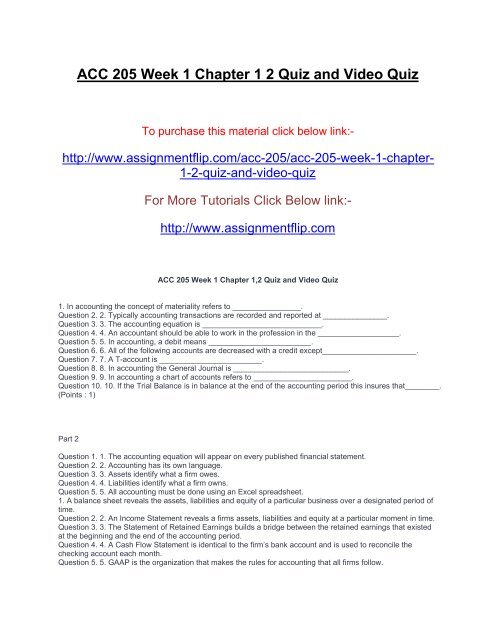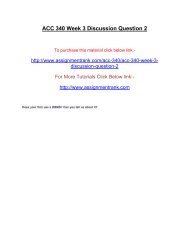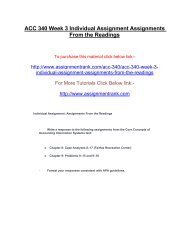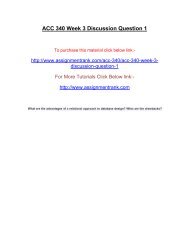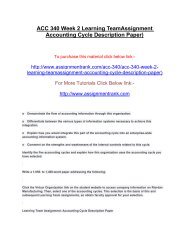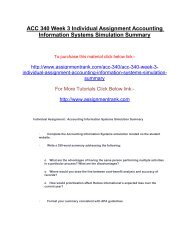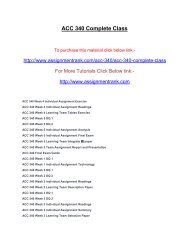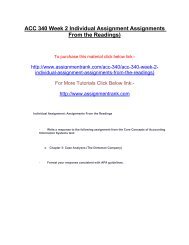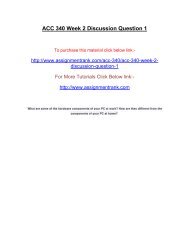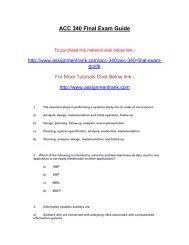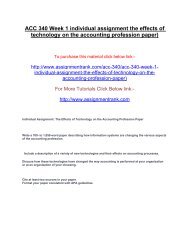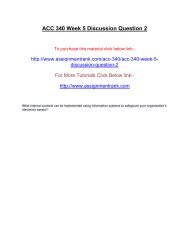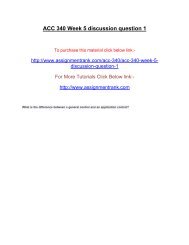ACC 205 Week 1 Chapter 1 2 Quiz and Video Quiz
To purchase this material click below link:- http://www.assignmentrank.com/acc-205/acc-205-week-1-chapter-1-2-quiz-and-video-quiz For More Tutorials Click Below link:- http://www.assignmentrank.com ACC 205 Week 1 Chapter 1,2 Quiz and Video Quiz 1. In accounting the concept of materiality refers to ________________. Question 2. 2. Typically accounting transactions are recorded and reported at _______________. Question 3. 3. The accounting equation is ____________________________. Question 4. 4. An accountant should be able to work in the profession in the ___________________. Question 5. 5. In accounting, a debit means ________________________. Question 6. 6. All of the following accounts are decreased with a credit except______________________. Question 7. 7. A T-account is ________________________. Question 8. 8. In accounting the General Journal is ___________________________. Question 9. 9. In accounting a chart of accounts refers to _______________________. Question 10. 10. If the Trial Balance is in balance at the end of the accounting period this insures that________. (Points : 1)
To purchase this material click below link:-
http://www.assignmentrank.com/acc-205/acc-205-week-1-chapter-1-2-quiz-and-video-quiz
For More Tutorials Click Below link:-
http://www.assignmentrank.com
ACC 205 Week 1 Chapter 1,2 Quiz and Video Quiz
1. In accounting the concept of materiality refers to ________________.
Question 2. 2. Typically accounting transactions are recorded and reported at _______________.
Question 3. 3. The accounting equation is ____________________________.
Question 4. 4. An accountant should be able to work in the profession in the ___________________.
Question 5. 5. In accounting, a debit means ________________________.
Question 6. 6. All of the following accounts are decreased with a credit except______________________.
Question 7. 7. A T-account is ________________________.
Question 8. 8. In accounting the General Journal is ___________________________.
Question 9. 9. In accounting a chart of accounts refers to _______________________.
Question 10. 10. If the Trial Balance is in balance at the end of the accounting period this insures that________. (Points : 1)
You also want an ePaper? Increase the reach of your titles
YUMPU automatically turns print PDFs into web optimized ePapers that Google loves.
<strong>ACC</strong> <strong>205</strong> <strong>Week</strong> 1 <strong>Chapter</strong> 1 2 <strong>Quiz</strong> <strong>and</strong> <strong>Video</strong> <strong>Quiz</strong><br />
To purchase this material click below link:-<br />
http://www.assignmentflip.com/acc-<strong>205</strong>/acc-<strong>205</strong>-week-1-chapter-<br />
1-2-quiz-<strong>and</strong>-video-quiz<br />
For More Tutorials Click Below link:-<br />
http://www.assignmentflip.com<br />
<strong>ACC</strong> <strong>205</strong> <strong>Week</strong> 1 <strong>Chapter</strong> 1,2 <strong>Quiz</strong> <strong>and</strong> <strong>Video</strong> <strong>Quiz</strong><br />
1. In accounting the concept of materiality refers to ________________.<br />
Question 2. 2. Typically accounting transactions are recorded <strong>and</strong> reported at _______________.<br />
Question 3. 3. The accounting equation is ____________________________.<br />
Question 4. 4. An accountant should be able to work in the profession in the ___________________.<br />
Question 5. 5. In accounting, a debit means ________________________.<br />
Question 6. 6. All of the following accounts are decreased with a credit except______________________.<br />
Question 7. 7. A T-account is ________________________.<br />
Question 8. 8. In accounting the General Journal is ___________________________.<br />
Question 9. 9. In accounting a chart of accounts refers to _______________________.<br />
Question 10. 10. If the Trial Balance is in balance at the end of the accounting period this insures that________.<br />
(Points : 1)<br />
Part 2<br />
Question 1. 1. The accounting equation will appear on every published financial statement.<br />
Question 2. 2. Accounting has its own language.<br />
Question 3. 3. Assets identify what a firm owes.<br />
Question 4. 4. Liabilities identify what a firm owns.<br />
Question 5. 5. All accounting must be done using an Excel spreadsheet.<br />
1. A balance sheet reveals the assets, liabilities <strong>and</strong> equity of a particular business over a designated period of<br />
time.<br />
Question 2. 2. An Income Statement reveals a firms assets, liabilities <strong>and</strong> equity at a particular moment in time.<br />
Question 3. 3. The Statement of Retained Earnings builds a bridge between the retained earnings that existed<br />
at the beginning <strong>and</strong> the end of the accounting period.<br />
Question 4. 4. A Cash Flow Statement is identical to the firm’s bank account <strong>and</strong> is used to reconcile the<br />
checking account each month.<br />
Question 5. 5. GAAP is the organization that makes the rules for accounting that all firms follow.
1. Journal entries must be prepared before financial statements can be created for a firm.<br />
Question 2. 2. T-accounts are part of the published financial reporting package of statements each month.<br />
Question 3. 3. An Income Statement will explain the value of current assets a firm has acquired.<br />
Question 4. 4. Liabilities will be listed on a firm’s balance sheet.<br />
Question 5. 5. Dividends are part of current assets for a firm since they will be paid with cash.<br />
Question 1. 1. In accounting a debit indicates an increase in an account.<br />
Question 2. 2. In accounting a credit increases a liability account.<br />
Question 3. 3. In accounting a credit increases an asset account.<br />
Question 4. 4. In accounting there are no debits or credits entered in the equity accounts.<br />
Question 5. 5. A trial balance is a listing of all accounts <strong>and</strong> their balances at a given moment in time.


